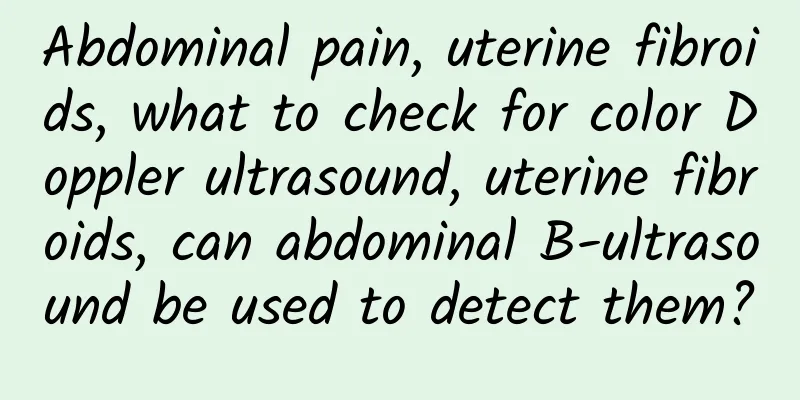Abdominal pain, uterine fibroids, what to check for color Doppler ultrasound, uterine fibroids, can abdominal B-ultrasound be used to detect them?

|
Abdominal pain is a common phenomenon and may be caused by various reasons, including uterine fibroids. Uterine fibroids are a common tumor in the female reproductive system that can cause abdominal pain and other related symptoms. So, what color Doppler ultrasound should be used to check uterine fibroids? In addition, I also want to know whether uterine fibroids can be detected through abdominal B-ultrasound? This article will answer these questions for you. In order to accurately diagnose uterine fibroids, color Doppler ultrasound (color Doppler ultrasound) is required. Color Doppler ultrasound is a commonly used non-invasive examination method that can provide more information, such as the size, shape, location, blood supply, and relationship with surrounding structures of the mass. This information is very important for diagnosis and treatment decisions. Next, let's take a look at which color Doppler ultrasound is more appropriate for examining uterine fibroids. Given that uterine fibroids are masses located inside the uterine wall, generally speaking, it is feasible to choose transabdominal color Doppler ultrasound or transvaginal color Doppler ultrasound for examination. Transabdominal color Doppler ultrasound is performed through the abdominal wall and is suitable for cases where the uterine fibroids are large or located on the surface of the uterus. On the other hand, transvaginal color Doppler ultrasound requires the probe to be inserted into the vagina, which can provide clearer images and is suitable for cases where the uterine fibroids are small or located in the endometrium. Therefore, according to the patient's specific situation and the doctor's advice, the appropriate color Doppler ultrasound method can be selected for examination. Below, we list some precautions and steps for using color Doppler ultrasound to examine uterine fibroids: 1. Make an appointment for color ultrasound examination: Before undergoing a color ultrasound examination, you need to make an appointment in advance to ensure that there is enough time for the examination. 2. Be prepared: Before the color Doppler ultrasound examination, you need to eat a light diet and avoid drinking a lot of water and eating to avoid affecting the examination results. At the same time, you need to clean your vagina to ensure the insertion of the color Doppler ultrasound probe and the smooth progress of the examination. 3. Examination process: During the color Doppler ultrasound examination, the patient needs to lie on the examination bed and the abdomen or vagina will be examined. The doctor will apply a special gel to the abdominal wall or probe to allow the ultrasound to be better transmitted into the body, and then the doctor will move the probe to obtain the required image. By following the above steps and using color Doppler ultrasound, doctors can accurately detect the presence, size, and distribution of uterine fibroids. Regarding the question of whether abdominal B-ultrasound can detect uterine fibroids, the answer is yes. Abdominal B-ultrasound is a commonly used examination method that can detect the conditions of various organs and structures, including the uterus. Therefore, abdominal B-ultrasound can be used to detect uterine fibroids, but compared with color Doppler ultrasound, abdominal B-ultrasound may not provide more detailed and accurate information. If you have abdominal pain and suspect it is caused by uterine fibroids, color Doppler ultrasound is a more accurate and commonly used method. The choice of transabdominal or transvaginal color Doppler ultrasound depends on the specific situation of the uterine fibroids. In addition, abdominal B-ultrasound can also detect uterine fibroids, but color Doppler ultrasound may be more suitable for providing more detailed and accurate information. If you have related symptoms or concerns, it is recommended to consult a doctor in time and undergo appropriate examinations. |
<<: At what age do uterine fibroids usually occur? At what age do uterine fibroids usually occur?
>>: What are the 4 signs of uterine fibroids? The most common symptoms of uterine fibroids
Recommend
Can threatened abortion be prevented by taking medicine?
Medication for threatened abortion may be helpful...
Prevention of ovarian cysts is very important for women
Ovarian cysts are common benign tumors. Ovarian c...
How to prevent premature menopause
How to prevent premature amenorrhea? Premature am...
Can chronic cervicitis in women be completely cured? Three effective treatments for chronic cervicitis
The treatment of chronic cervicitis is relatively...
Why does threatened miscarriage occur?
Why does threatened miscarriage occur? During pre...
Which department or clinic should I go to for abortion? Does abortion require family signature?
Which department and clinic should I go to for ab...
What are the symptoms of functional uterine bleeding due to Yin deficiency syndrome?
Recently, Xiaoyuan's menstruation seems to be...
How long does it take to get pregnant after laparoscopic surgery for ectopic pregnancy
After laparoscopic surgery for ectopic pregnancy,...
What are the main factors that cause ovarian cysts?
What are the common causes of ovarian cysts? The ...
The harmful effects of ovarian cysts on women
Ovarian cysts are mainly lumps that form inside o...
What foods are likely to cause miscarriage? Late childbearing increases the chance of miscarriage
After pregnancy, for the sake of the baby's n...
Do you know the dangers of adnexitis?
What are the hazards of adnexitis? Do you know wh...
Brief analysis of two common types of cervical erosion
There are two types of cervical erosion that are ...
Can drinking hot lemon water help detox? Nutritionists reveal the truth behind 10 health myths
What health decisions have you made recently? Giv...
Is it impossible to get pregnant if you have chronic adnexitis?
Is it impossible to get pregnant if you have chro...









